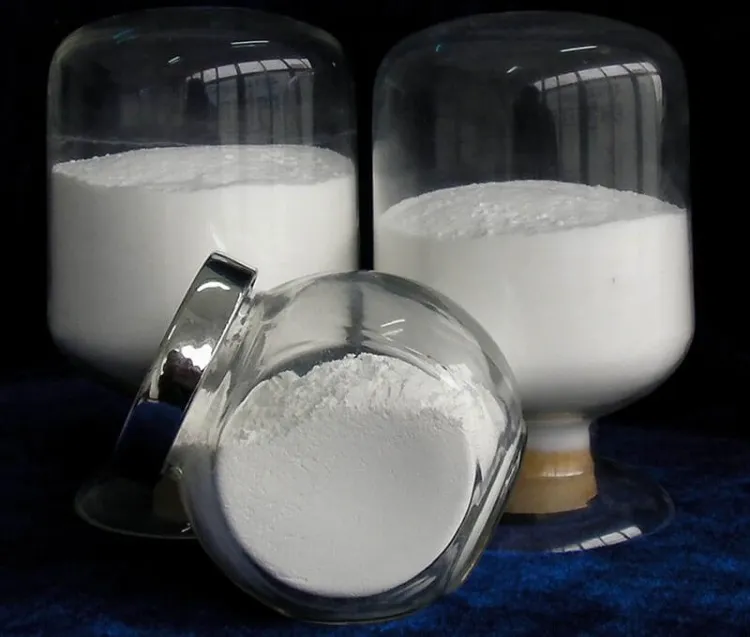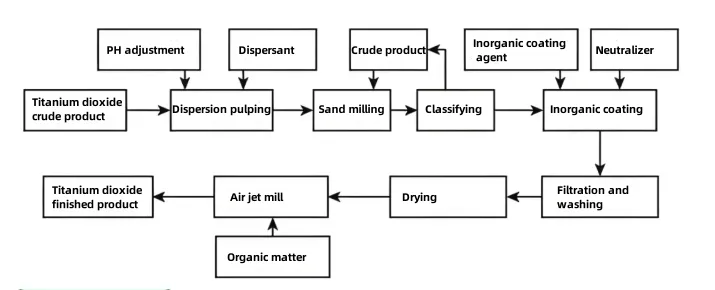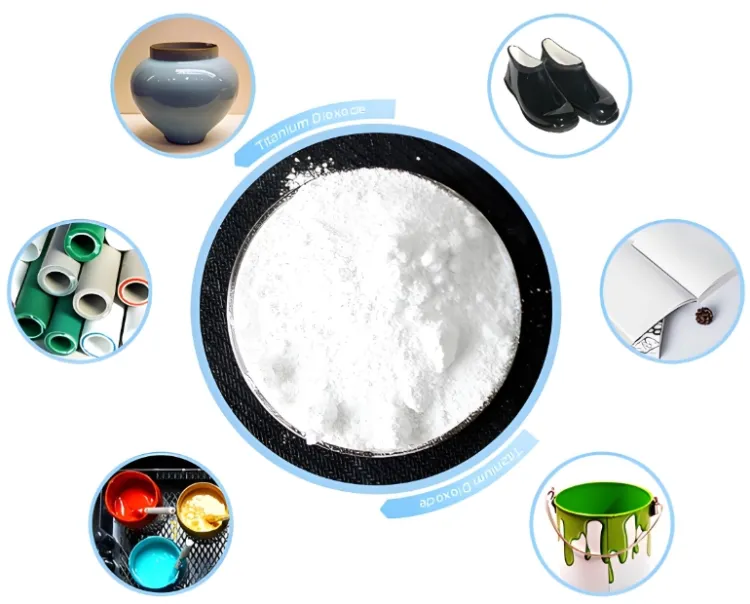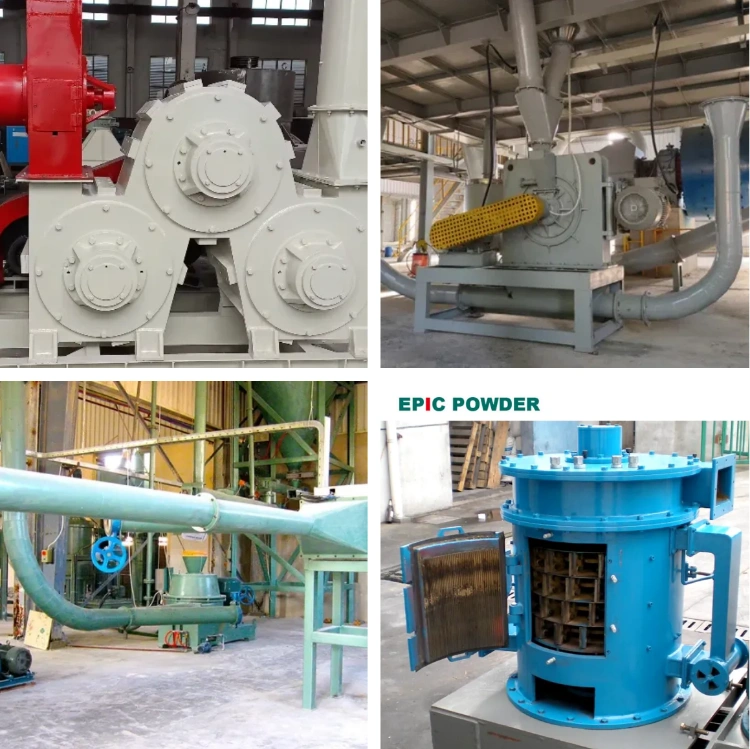The мадыфікацыя пакрыцця з дыяксід тытана (TiO₂) — важны метад паляпшэння яго ўласцівасцей, такіх як дысперсія, устойлівасць да надвор'я, бляск і хімічны стабільнасць. Дзякуючы дыяксіду тытана пакрыццё Мадыфікацыя дазваляе значна палепшыць характарыстыкі TiO₂ для розных прамысловых ужыванняў. Распаўсюджаныя метады пакрыцця ў асноўным падзяляюцца на тры катэгорыі: неарганічныя пакрыцці, арганічныя пакрыцці і кампазітныя пакрыцці. Ніжэй прыведзена канкрэтная класіфікацыя і кароткае апісанне гэтых метадаў мадыфікацыі пакрыццяў дыяксідам тытана, з падкрэсліваннем іх унікальных пераваг для розных ужыванняў.

Мадыфікацыя неарганічнага пакрыцця
Па пакрыццё пласт неарганічных аксідаў або соляў на паверхні часціц дыяксіду тытана, утвараецца фізічны бар'ер для паляпшэння яго хімічнай стабільнасці і аптычных уласцівасцей.

Аксіднае пакрыццё
прынцып: Гідраты аксідаў металаў (напрыклад, SiO₂, Al₂O₃, ZrO₂) асядаюць на паверхні TiO₂, утвараючы аднастайны пласт пакрыцця.
Распаўсюджаныя тыпы:
- Пакрыццё з крэмнію (SiO₂): Паляпшае дысперсію і ўстойлівасць да атмасферных уздзеянняў, памяншае агламерацыю, выкарыстоўваецца ў пакрыццях і пластмасах.
- Пакрыццё з аксіду алюмінію (Al₂O₃): Паляпшае палярнасць паверхні, сумяшчальнасць з арганічнымі матрыцамі, павялічвае бляск і хімічную ўстойлівасць.
- Пакрыццё з аксіду цырконія (ZrO₂): Павышае ўстойлівасць да высокіх тэмператур і зносаўстойлівасць, падыходзіць для высокапрадукцыйных пакрыццяў і керамікі.
Працэс: Солі металаў (напрыклад, сілікат натрыю, сульфат алюмінію) дадаюцца ў суспензію TiO₂, рэгулюючы pH для асаджэння гідратаў аксіду металу.
Кампазітнае аксіднае пакрыццё
прынцып: Пакрыццё з двух або больш аксідаў металаў (напрыклад, Al₂O₃-SiO₂, ZrO₂-SiO₂) спалучае ў сабе перавагі кожнага кампанента.
Характарыстыкі: Забяспечвае найлепшыя агульныя характарыстыкі. Напрыклад, пакрыццё Al₂O₃-SiO₂ паляпшае як дысперсію, так і ўстойлівасць да атмасферных уздзеянняў, што падыходзіць для высокапрадукцыйных аўтамабільных фарбаў і пакрыццяў рулонаў.
Солевае пакрыццё
прынцып: Солі металаў (напрыклад, фасфаты, сілікаты, сульфаты) утвараюць нерастваральныя солевыя пласты на паверхні TiO₂.
Распаўсюджаныя тыпы:
- Пакрыццё з фасфату алюмінію: Павышае ўстойлівасць да надвор'я і здольнасць супрацьстаяць рассыпістю, звычайна выкарыстоўваецца ў вонкавых пакрыццях.
- Пакрыццё сульфатам цынку: Паляпшае ўласцівасці паверхневага зарада, памяншае агламерацыю і паляпшае дысперсію.
Мадыфікацыя арганічнага пакрыцця
У выніку рэакцыі арганічных злучэнняў з гідраксільнымі групамі на паверхні дыяксіду тытана ўтвараецца арганічны малекулярны пласт, які паляпшае яго сумяшчальнасць з арганічнымі асяроддзямі.
Пакрыццё злучным агентам
прынцып: Малекулы злучальных агентаў (напрыклад, сіланы, тытанаты, алюмінаты) маюць амфіфільную структуру, адзін канец якой звязаны з гідраксільнымі групамі TiO₂, а другі рэагуе з арганічнымі матрыцамі (напрыклад, смаламі, палімерамі).
Функцыя:
- Сіланавыя злучныя агенты: Паляпшае дысперсію TiO₂ у водных сістэмах, звычайна выкарыстоўваецца ў пакрыццях і чарнілах на воднай аснове.
- Тытанатныя/алюмінатныя злучныя агенты: Паляпшае сумяшчальнасць у алейных сістэмах, такіх як пластмасы і гумы, памяншаючы агламерацыю падчас апрацоўкі.
Пакрыццё павярхоўна-актыўнымі рэчывамі
прынцып: Павярхоўна-актыўныя рэчывы (напрыклад, тоўстыя кіслоты, сульфанаты, чацвярцічныя амоніевыя солі) прымацоўваюцца да паверхні TiO₂ шляхам фізічнай адсорбцыі або хімічных рэакцый, утвараючы зарад або гідрафобны пласт.
Функцыя:
- Аніённыя павярхоўна-актыўныя рэчывы (напрыклад, стэарынавая кіслата): Паляпшае дысперсію ў алейных асяроддзях, звычайна выкарыстоўваецца ў пластмасах і гуме.
- Катыённыя павярхоўна-актыўныя рэчывы (напрыклад, дадэцылтрыметыламоній хларыд): Падыходзіць для палярных сістэм, павышаючы стабільнасць.
Палімернае пакрыццё
прынцып: Прышчэпка палімераў (напрыклад, акрылатаў, эпаксідных смол, сілаксанаў) дасягаецца шляхам рэакцый палімерызацыі на паверхні TiO₂.
Функцыя: Утварае тоўсты пласт пакрыцця, які дадаткова ізалюе хімічную карозію, паляпшае ўстойлівасць да надвор'я і механічныя ўласцівасці. Паляпшае сумяшчальнасць са спецыфічнымі смоламі, падыходзіць для высокапрадукцыйных кампазітаў і пакрыццяў.
Сіліконавае пакрыццё
прынцып: Поліарганасілаксаны (напрыклад, сіліконы, сіліконавыя смалы) пакрываюць часціцы TiO₂ дзякуючы сваім уласцівасцям нізкай павярхоўнай энергіі.
Функцыя: Зніжае павярхоўнае нацяжэнне, паляпшае дысперсію і гладкасць, звычайна выкарыстоўваецца ў чарнілах і касметыцы.
Мадыфікацыя кампазітнага пакрыцця
Спалучаючы перавагі неарганічных і арганічных пакрыццяў, падвойнае пакрыццё выконваецца паэтапна або адначасова для дасягнення дадатковай прадукцыйнасці.
Спачатку неарганічнае, потым арганічнае пакрыццё
Працэс: Спачатку ствараюць фізічны бар'ер з неарганічных аксідаў (напрыклад, SiO₂), а затым мадыфікуюць злучнымі агентамі або палімерамі для ўзмацнення арганічных уласцівасцей.
Характарыстыкі: Забяспечвае баланс паміж устойлівасцю да надвор'я і сумяшчальнасцю, напрыклад, у высокаўстойлівых да надвор'я архітэктурных пакрыццях або аўтамабільных фарбах вытворцаў арыгінальнага абсталявання.
Неарганічна-арганічнае сінхроннае пакрыццё
Працэс: Адначасова ўводзяць неарганічныя і арганічныя пакрыцці ў адну рэакцыйную сістэму для ўтварэння структуры «ядро-абалонка».
Характарыстыкі: Пласты пакрыцця злучаюцца больш шчыльна, што прыводзіць да значнага паляпшэння прадукцыйнасці. Падыходзіць для высокакласных ужыванняў, такіх як аэракасмічныя пакрыцці і нанакампазіты.
Іншыя спецыяльныя тэхналогіі пакрыццяў
Нанапакрыццё
прынцып: Выкарыстоўвайце нанаматэрыялы (напрыклад, нанаSiO₂, нанаZnO) для пакрыццяў, каб палепшыць здольнасць абараняць ад ультрафіялетавага выпраменьвання і празрыстасць, звычайна выкарыстоўваюцца ў сонцаахоўнай касметыцы і аптычных пакрыццях.
Пакрыццё мікракапсул
прынцып: Змяшчае часціцы TiO₂ у палімерныя мікракапсулы, вызваляючы TiO₂, кантралюючы ўмовы разрыву капсулы (напрыклад, тэмпературу, pH). Падыходзіць для разумных пакрыццяў і сістэм кантраляванага вызвалення.
Заключэнне
Выбар мадыфікацыя пакрыцця дыяксідам тытана павінна грунтавацца на сцэнарыі прымянення (напрыклад, пакрыцці, пластмасы, чарніла, касметыка) і патрабаваннях да эксплуатацыйных характарыстык (напрыклад, устойлівасць да надвор'я, дысперсія, сумяшчальнасць).

Напрыклад:
- Вонкавыя пакрыцці: Для павышэння ўстойлівасці да ўздзеяння надвор'я пераважней выкарыстоўваць неарганічныя аксіды (напрыклад, Al₂O₃-SiO₂) або кампазітныя пакрыцці.
- Апрацоўка пластыка: Злучныя агенты або павярхоўна-актыўныя рэчывы выкарыстоўваюцца для паляпшэння дысперсіі і эфектыўнасці апрацоўкі.
- Высокакласныя праграмы: Кампазітныя або нанапакрыцці дазваляюць дасягнуць шматфункцыянальнай сінергетычнай аптымізацыі.

Эпічны парашок
Epic Powder, больш за 20 гадоў вопыту працы ў галіне ультратонкіх парашкоў. Актыўна садзейнічаем будучым распрацоўкам ультратонкіх парашкоў, засяроджваючыся на працэсах драбнення, здрабнення, класіфікацыі і мадыфікацыі ультратонкіх парашкоў. Звяжыцеся з намі для бясплатнай кансультацыі і індывідуальных рашэнняў! Наша каманда экспертаў імкнецца прадастаўляць высакаякасныя прадукты і паслугі для максімальнага павелічэння каштоўнасці вашай апрацоўкі парашкоў. Epic Powder — ваш надзейны эксперт па апрацоўцы парашкоў!
